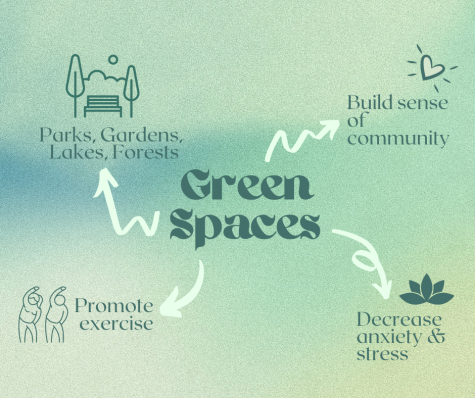
Twitter: @Katherine00718

X: arianna_z_news
May 29, 2023
Central Park in New York City. Golden Gate Park in San Francisco. Lincoln Park in Chicago.
All three are examples of sprawling green spaces built amid large urban areas. These spaces create pockets of nature within the busy, concrete scenery of cities and can be parks, lakes, forests, gardens, and more.
Incorporating nature in cities through the development of green spaces combats both the mental and physical health issues created by urbanization.
“We know that when people spend more time in nature, they feel better and have better mental health outcomes. There’s not as much stress. In general, nature is synonymous with taking time for yourself and relaxing, spending time with family and friends, and doing things in a nice, quiet environment,” Avilla said.

The greenery and calmness in parklands are a direct contrast to raucous, gray cities, encouraging the anxiety and stress from city living to melt away. The simple act of being in a natural, uncultivated environment can be a mental reset for people under constant stress.
San Mateo County’s Outdoor Education program is an excellent example of the metamorphic effects of nature. When students first arrive in the forest for the program, they’re immediately immersed in the wilderness.
“You get off the bus, and you’re immediately in this beautiful, forested area: the ground is uneven, with roots and fallen logs. Kids are climbing over things and picking up stuff they find on the ground, and that is the hands-on connection that students get to have with nature and the environment at Outdoor Ed. It’s transformational,” Collins said.
Natural settings provide both kids and adults with a sense of peace and wonder. Green spaces provide a highly beneficial service as they give solace to urban residents wishing to take a break from the fast-paced city life. They also double as areas to exercise.
“Green spaces are very valuable. They tend to encourage you to want to walk around in those spaces or move around, which can alleviate some of the detriments of the sedentary lifestyle of cities. It’s good to have green spaces and safe routes through those areas that people can use regularly,” Hedge said.
Research from Denmark’s University of Aarhus discovered that city residents living without any green spaces nearby had up to a 55 percent increased risk of developing psychiatric disorders like depression and substance abuse.
“Cities with many parks and green areas interspersed throughout communities had fewer mental health issues,” Avilla said.
However, despite the apparent benefits of green spaces, many believe they are too expensive and not worth the investment. For instance, Central Park in New York City cost $14 million to build.
People concerned about the expenses must realize that green spaces are becoming more of a necessity and less of a luxury. Mental health disorders have increased by 13 percent in the past decade, with urbanites being most vulnerable, so parklands in cities are increasingly vital to maintaining a high quality of life.
Collins has observed the joy and carefree attitude that kids and adults alike have experienced from being in nature.
“Watching children interact in this space, where they’re singing a song in front of a cracking campfire or watching the waves on the beach, is a calming experience for our staff,” Collins said.
While the continuation of urbanization is inevitable, community members and city designers can confront the concrete consequences of city building and decide to change how the world urbanizes. If this is possible, then who knows?
Maybe someday, kids will be able to wish upon a star once again.

